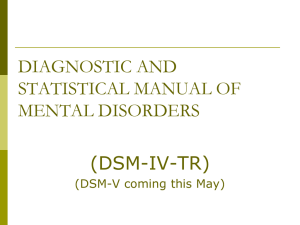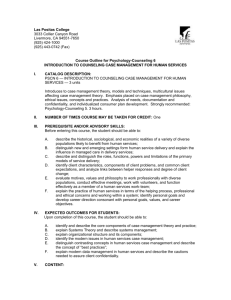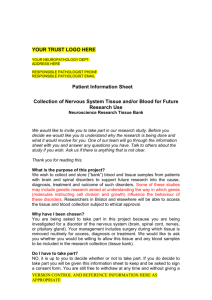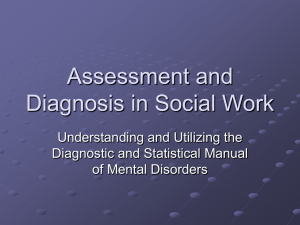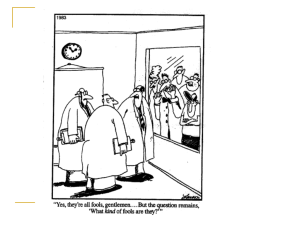Diagnosis and Classification of Psychological Problems
advertisement
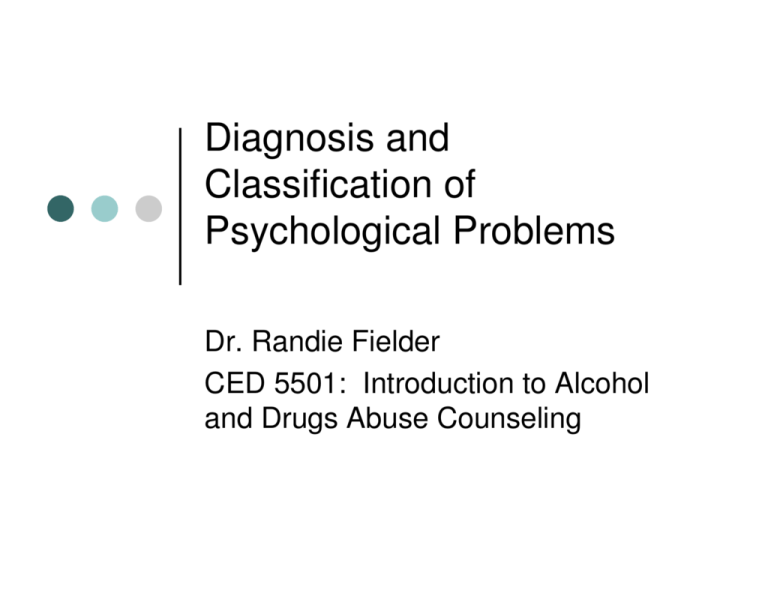
Diagnosis and Classification of Psychological Problems Dr. Randie Fielder CED 5501: Introduction to Alcohol and Drugs Abuse Counseling Definitions of Abnormal Behavior Conformity to norms: Statistical Infrequency or Violation of Social Norms Subjective distress Disability or dysfunction Conformity to norms: Statistical Infrequency or Violation of Social Norms A person’s behavior is abnormal if it is statistically infrequent (deviates significantly from the average is above the “cutoff point” A person’s behavior is abnormal if it is very unusual Assessment of Abnormal Behavior Assessment = The systematic evaluation and measurement of psychological, biological, and social factors in an individual presenting with a possible psychological disorder Diagnosis = The process of determining whether the presenting problem(s) fit the criteria for a particular mental disorder Subjective distress A behavior or symptoms are abnormal if they causes the person distress? Disability or dysfunction A behavior is abnormal if it creates some degree of social (interpersonal) or occupational problems Disability or dysfunction Advantages Requires little inference These type of problems often prompt treatment seeking Disadvantages Difficulty establishing standards for occupational or social dysfunction Diagnostic and Statistical Manual-IV-TR …The most widely accepted definition used in DSM-IV-TR describes behavioral, emotional or cognitive dysfunctions that are unexpected in their cultural context and associated with personal distress or substantial impairment in functioning. Current Diagnostic Systems In 1948 the World Health organization (WHO) added a section on classification of mental disorders to the International Classification of Diseases and Health Related Problems ICD-10: current system developed in 1990 In 1952 the American Psychiatric Association developed and published its own Diagnostic and Statistical Manual DSM-IV-TR was published in 2000 DSM-III and DSM-III-R Changes Not based on a specific theory Presented explicit diagnostic criteria Multiaxial system The specificity of diagnostic criteria made it possible to examine the reliability and validity of diagnostic categories Multiaxial System I. Clinical syndromes II. Personality disorders and developmental disorders III. Physical conditions (e.g. diabetes) IV. Severity of psychosocial stressors V. Highest level of adaptive functioning in the past year DSM-III: Shortcomings Unacceptably low reliability in some diagnostic categories. Hierarchical diagnostic system. DSM-III-R Published in 1987 Eliminated some problems such as hierarchical diagnoses DSM-IV and DSM-IV-TR DSM-IV (1994) Revisions were based on empirical data generated by DSM-III and DSM-III-R Reorganization Axis IV: Rating of severity of stressors changed to a checklist Axis V ratings changed to GAF (Global Assessment of Functioning) 1=Markedly poor functioning 90= Superior functioning DSM-IV-TR Only changes in the descriptions of some of the disorders DSM-IV-TR Current diagnostic system Multiaxial: Axis I: Clinical Disorders Developmental Dis.(not mental retardation Axis II: Personality Disorders Mental Retardation Axis III: General Medical Conditions Axis IV: Contributing Problems Axis V: Rating of Functioning DSM-IV-TR: An example 13 year old Hispanic female Completing a gifted and talented program Feeling increasingly depressed, having more suicidal thoughts Irritable, oppositional, and difficult to manage Loss of energy, appetite Conflicts with peers and family Changed schools, father hospitalized DSM-IV Diagnosis Axis I: Axis II: Axis III: Axis IV Axis V Diagnosis: Positive Aspects •Facilitates communication (verbal shorthand) •Ensures comparability among identified patients •Promotes research on diagnostic features, etiology and treatment Diagnosis: Negative Aspects Boundaries between disorders are often fuzzy Gender bias in application of diagnostic labels Negative effects of labeling on other’s perceptions Negative effects of labeling on self-concept Gender Bias in Diagnoses The gender of the patient influences the diagnosis, despite the presentation of equivalent symptoms Sex Bias in the Diagnosis of Borderline Personality Disorder and Posttraumatic Stress Disorder (Becker and Lam, 1994) 1. Subjects (n=1,082) •Social Workers •Psychologist •Psychiatrists 2. Procedure •Case study with PTSD or BPD symptoms •Male and female cases •Clinicians rated case studies on a 7 point scale the extent to which a client appeared to have each of the Axis I and Axis II disorders 3. Results Clinicians rated female clients higher for applicability of BPD diagnosis than male clients Objective psychological tests Format Standardized MMPI-2, BDI, WAIS-III Reliable Projective psychological tests Format Rorschach TAT Drawings Advantages Disadvantages Behavioral Observations In MSE, but in other assessments as well Behavioral orientation Neuropsychological (NP) Testing and Neurological Exams NP testing: Test many areas of functioning Locate affected brain areas Advantage Neurological exams: CAT, MRI PET Case example Susie went to Boynton and reported feeling a great deal of stress - she just broke up with her boyfriend, and she can’t pay off her credit card bill this month (she has had many co-pays recently, given her recent diagnosis of hypothyroidism) and has turned to alcohol to help her cope. She meets criteria for depression, borderline personality disorder as well as alcohol dependence. She said she rarely attends class anymore, and feels she doesn’t have enough social support. What info would go on each axis? Classification: summary Classification refers to diagnosing people. There are pros and cons to it. A useful classification system should be reliable and valid. The DSM takes a multiaxial prototypical approach.
